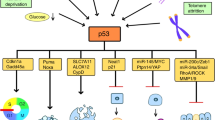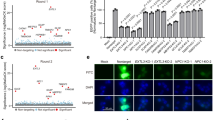Abstract
The insect baculovirus Autographa californica multiple nuclear polyhedrosis virus (AcMNPV) has been evaluated as a vector for gene delivery to human tumor cells. A human osteogenic sarcoma cell line, Saos-2, was found to be highly susceptible to infection with a baculoviral vector, with nearly 100% of Saos-2 cells being able to express a lacZ reporter gene after a brief exposure to the virus at a m.o.i. of 30 pfu/cell. The production of β-galactosidase protein was 18-times greater than that in HepG2 cells which were previously thought to be the mammalian cells most susceptible to the baculovirus. The possibility of developing a baculovirus as a cytotoxic vector for p53-defective cancer was tested by destruction of Saos-2 cells (p53-/-) with a recombinant baculovirus containing the wild type p53 gene (BV-p53) in vitro. The p53 baculovirus induced apoptotic cell death in tumor cells in a dose-dependent manner with ∼60% killing at an m.o.i. of 160 pfu/cell. Combined treatments of gene therapy (p53) and chemotherapy (adriamycin) resulted in synergistic and potent killing of the osteogenic sarcoma cells. For example, greater than 95% of Saos-2 cells were killed by the combination of BV-p53 (m.o.i. of 100) and adriamycin (35 ng/ml), whereas ∼50% and ∼55% cells were killed by BV-p53 and adriamycin alone, respectively. These results indicate that a baculoviral gene delivery vector can be used to efficiently target certain types of mammalian cells and the combination treatment of gene-therapy mediated by a baculovirus and chemotherapy may enhance induction of apoptosis in cancer cells.
Similar content being viewed by others
Article PDF
Author information
Authors and Affiliations
Rights and permissions
This is an Open Access article distributed under the terms of the Creative Commons Attribution Non-Commercial License (http://creativecommons.org/licenses/by-nc/3.0/) which permits unrestricted non-commercial use, distribution, and reproduction in any medium, provided the original work is properly cited.
About this article
Cite this article
Song, S., Boyce, F. Combination treatment for osteosarcoma with baculoviral vector mediated gene therapy (p53) and chemotherapy (adriamycin). Exp Mol Med 33, 46–53 (2001). https://doi.org/10.1038/emm.2001.9
Published:
Issue Date:
DOI: https://doi.org/10.1038/emm.2001.9
Keywords
This article is cited by
-
Recombinant baculovirus expressing the FrC-OVA protein induces protective antitumor immunity in an EG7-OVA mouse model
Journal of Biological Engineering (2019)
-
p53 gene therapy of human breast carcinoma: using a transferrin-modified silica nanoparticles
Breast Cancer (2016)
-
The cholesterol metabolite 27-hydroxycholesterol regulates p53 activity and increases cell proliferation via MDM2 in breast cancer cells
Molecular and Cellular Biochemistry (2015)
-
Induction of antitumor immunity against mouse carcinoma by baculovirus-infected dendritic cells
Cellular & Molecular Immunology (2010)
-
Recombinant Baculovirus as a Highly Potent Vector for Gene Therapy of Human Colorectal Carcinoma: Molecular Cloning, Expression, and In Vitro Characterization
Molecular Biotechnology (2010)



